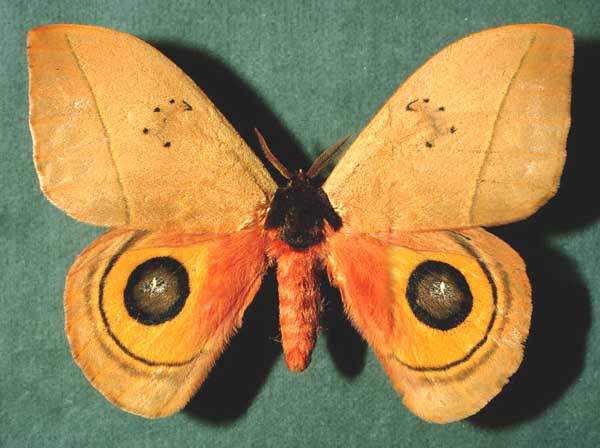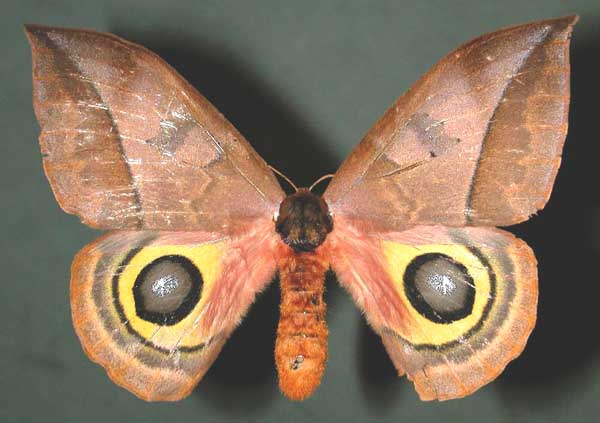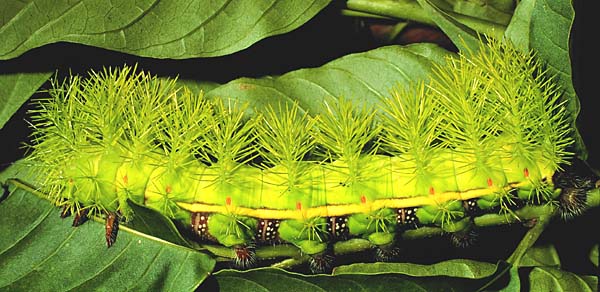Automeris belti
|
|
Updated from Lemaire's Hemileucinae, 2002, October 13, 2005;
January 12, 2007
Updated as per communication from Jean Michel Maes (Nicaragua), March 2007
Updated as per communication from Ronald D. Cave (Honduras), July 2007
Updated as per
http://www.inbio.ac.cr/bims/k02/p05/c029/o0119/f00885.htm IB, April 2008
Updated as per personal communication with Leroy Simon (Golfito, May 2008), June 2008
Updated as per personal communication with Maxime Pastore (Bartola, Rio San Juan, Nicaragua); March 12, 2016
|
Automeris belti
awe-too-MER-ihsMBELT-eye
Druce, 1886

Automeris belti male, Costa Rica, courtesy of Dan Janzen.
This site has been created by
Bill Oehlke at oehlkew@islandtelecom.com
Comments, suggestions and/or additional information are welcomed by Bill.
TAXONOMY:
Superfamily: Bombycoidea, Latreille, 1802
Family: Saturniidae, Boisduval, [1837] 1834
Subfamily: Hemileucinae, Grote & Robinson, 1866
Tribe: Hemileucini, Grote & Robinson, 1866
Genus: Automeris, Hubner, [1819] |
MIDI MUSIC
"Someone to Watch Over Me"
copyright C. Odenkirk
ON.OFF
<bgsound src="watch.mid" LOOP=FOREVER>
|
DISTRIBUTION:
Automeris belti belti
(wingspan: males: 91-93mm; females: 125mm) flies in
Nicaragua: Esteli, Chontales, Zelaya, Rio San Juan;
Mexico: Veracruz, Chiapas, Hidalgo, Puebla, (Oaxaca (KP)); and
Belize: Cayo, Toledo;
Honduras: Cortes (RC), Atlantida, Olancho, Yoro (RC);
Costa Rica: Heredia, Cartago, Limon,
Puntarenas (CL), Guanacaste, San Jose, Alejuela (IB);
Panama: Chiriqui, Colon, Canal Zone.
I suspect it also flies in eastern
Guatemala now confirmed in Izabal (JM).

Automeris belti male, Cortes, Honduras, courtesy/copyright
Eduardo Marabuto.
The forewing ground colour varies from light buff to brownish-beige to brown. The outer margin is oblique; the dark pm line is preapical and slightly
concave, inwardly bordered with yellow. The am line is angulate and outwardly bordered with yellow. The cell is darker than its surroundings
and is accentuated with black dots.

Automeris belti male, Bartola, Rio San Juan, Nicaragua,
courtesy of Maxime Pastore.
Visit Automeris belti, faded males, La Ceiba, Atlantida, Honduras,
April-May, 100-125mm, courtesy of Robert Lehman.

Automeris belti male, Golfito, Puntarenas, Costa Rica,
May 4, 2008, courtesy of Leroy Simon.
Hindwing ground colour is yellow-orange, with reddish hairs and
scales in the basal area, along the inner margin, and beneath the
forewing overlap. The hindwing pupil is black and oval and dusted
with white scales. The iris is large and light brown.
The black pm line is thin and smooth, outwardly followed by a thin yellow-orange
band, a thicker grey band and then a thick greyish-orange outer margin.

Automeris belti belti, male, Las Cuevas, Cayo, Belize, 93mm, courtesy of Art Gilbert and Norm Smith.
It is replaced by Automeris belti zaruma in Columbia,
Venezuela and Ecuador.
FLIGHT TIMES AND PREFERRED FOOD PLANTS:
Moths are on the wing in February-March, May, July and October in
Costa Rica, suggesting at least three broods.
Robert Lehman reports an April-May flight in La Ceiba, Atlantida, Honduras.
Automeris belti larvae feed
upon Cestrum racemosum, Ficus, Heliocarpus appendiculitus, Psidium guajava, Rhynchosia pyramidata and Senna papillosa.

Automeris belti female, courtesy of Dan Janzen.

Automeris belti female, Oaxaca, Mexico, 2000m, courtesy
of Kelly Price
ECLOSION, SCENTING AND MATING:
Automeris belti males use highly developed antennae to
locate mates at night by tracking the airbourne pheromone plume.
EGGS, LARVAE, COCOONS, AND PUPAE:
Automeris belti
larvae have urticating
spines and feed gregariously.
Pupation is
in a cocoon spun up amongst ground litter and surrounding grasses.

Listed below are the primary food plant(s) and alternate food plants
listed in Stephen E. Stone's Foodplants of World Saturniidae. It is hoped
that this alphabetical listing followed by the common name of the foodplant will
prove useful. The list is not exhaustive. Experimenting with closely
related foodplants is worthwhile.
Cestrum racemosum
Ficus
Heliocarpus appendiculitus.......
Psidium guajava
Rhynchosia pyramidata
Senna papillosa
| Cestrum racemosum
Fig
Heliocarpus appendiculitus
Common guava
Kanacabtsonot
Senna
|
Use your browser "Back" button to return to the previous page.
Return to Main Saturniidae Index
Return to Central American Automeris Index









